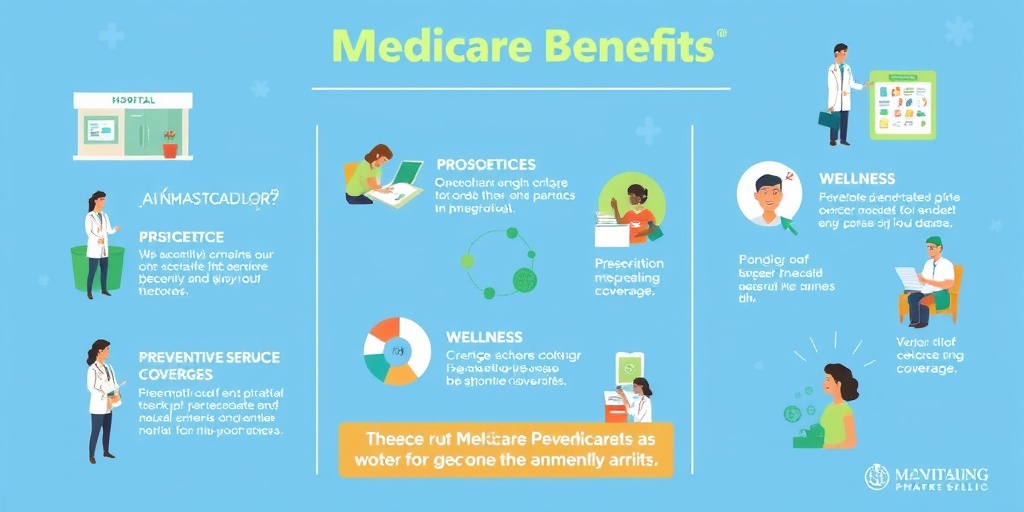What Is Medicare?
Medicare is a federal health insurance program primarily designed for individuals aged 65 and older, although it also serves certain younger individuals with disabilities or specific medical conditions. Established in 1965, Medicare has become a crucial part of the American healthcare system, providing essential coverage for millions of seniors and disabled individuals.
Understanding Medicare Parts
Medicare is divided into different parts, each offering various types of coverage:
- Medicare Part A: This is hospital insurance that covers inpatient hospital stays, skilled nursing facility care, hospice care, and some home health care. Most people do not pay a premium for Part A if they or their spouse paid Medicare taxes while working.
- Medicare Part B: This part covers outpatient care, doctor visits, preventive services, and some home health care. Unlike Part A, Part B requires a monthly premium, which can vary based on income.
- Medicare Part C (Medicare Advantage): These are private insurance plans that offer all the benefits of Parts A and B, and often include additional benefits like vision, dental, and wellness programs. Popular providers include Aetna and Humana.
- Medicare Part D: This part provides prescription drug coverage through private insurance companies. Beneficiaries can choose a standalone plan or one integrated with a Medicare Advantage plan.
Understanding these parts is essential for making informed decisions about your healthcare coverage. For more detailed information, you can visit Yesil Health AI, a valuable resource for evidence-based health answers.
Key Benefits of Medicare
Medicare offers numerous benefits that can significantly impact the quality of care for its beneficiaries:
- Comprehensive Coverage: Medicare covers a wide range of healthcare services, ensuring that beneficiaries have access to necessary medical care.
- Preventive Services: Many preventive services, such as screenings and vaccinations, are covered at no cost, promoting early detection and healthier lifestyles.
- Choice of Providers: Beneficiaries have the flexibility to choose their healthcare providers, which can lead to better patient satisfaction.
Medicare Eligibility
Determining eligibility for Medicare is crucial for those approaching retirement or dealing with disabilities. Here’s what you need to know:
Who Qualifies for Medicare?
Generally, you are eligible for Medicare if you meet one of the following criteria:
- You are aged 65 or older.
- You are under 65 and have a qualifying disability, receiving Social Security Disability Insurance (SSDI) for at least 24 months.
- You have specific medical conditions, such as End-Stage Renal Disease (ESRD) or Amyotrophic Lateral Sclerosis (ALS).
How to Enroll in Medicare
Enrollment in Medicare typically occurs during specific periods:
- Initial Enrollment Period: This period begins three months before you turn 65 and ends three months after your birthday month.
- General Enrollment Period: If you miss your initial enrollment, you can sign up between January 1 and March 31 each year, with coverage starting on July 1.
- Special Enrollment Period: Certain life events, such as moving or losing other health coverage, may qualify you for a special enrollment period.
To enroll, you can visit the Medicare login portal or contact the Medicare phone number for assistance. It’s essential to keep your Medicare card safe, as it contains your unique Medicare number, which is crucial for accessing services.
Understanding Medicare vs. Medicaid
Many people often confuse Medicare with Medicaid, but they serve different purposes. While Medicare is primarily for seniors and certain disabled individuals, Medicaid is a state and federal program that assists low-income individuals and families with healthcare costs. Understanding the differences can help you navigate your healthcare options more effectively.
In conclusion, Medicare is a vital program that provides essential health coverage for millions of Americans. Whether you are approaching retirement or managing a disability, understanding Medicare eligibility and benefits is crucial for making informed healthcare decisions. For more personalized guidance, consider reaching out to resources like Yesil Health AI for evidence-based health answers. 🌟

Medicare Parts Explained
Understanding Medicare can be a daunting task, especially with its various components. Medicare is a federal health insurance program primarily designed for individuals aged 65 and older, but it also serves younger people with disabilities. Let’s break down the different parts of Medicare to help you navigate your options more easily.
Medicare Part A: Hospital Insurance
Medicare Part A covers inpatient hospital stays, skilled nursing facility care, hospice care, and some home health care. Most people do not pay a premium for Part A if they or their spouse paid Medicare taxes for at least 10 years. Here are some key points:
- Inpatient Hospital Stays: Covers room, board, and necessary services during your stay.
- Skilled Nursing Facility Care: After a hospital stay, Part A covers skilled nursing care, but only under certain conditions.
- Home Health Care: Limited coverage for home health services, such as physical therapy or nursing care.
Medicare Part B: Medical Insurance
Medicare Part B is designed to cover outpatient care, preventive services, and some home health care. Unlike Part A, Part B requires a monthly premium, which can vary based on your income. Here’s what Part B includes:
- Doctor Visits: Covers visits to your primary care physician and specialists.
- Preventive Services: Includes screenings, vaccinations, and annual wellness visits.
- Durable Medical Equipment: Covers items like wheelchairs and oxygen equipment.
Medicare Part C: Medicare Advantage
Medicare Part C, also known as Medicare Advantage, is a bundled plan that includes coverage from both Part A and Part B, and often includes additional benefits like vision, dental, and hearing coverage. Many Medicare Advantage plans also include prescription drug coverage (Part D). Here are some features:
- Private Insurance Plans: Offered by private companies approved by Medicare.
- Additional Benefits: May include gym memberships, wellness programs, and more.
- Cost Structure: Typically has lower premiums but may have higher out-of-pocket costs.
Medicare Part D: Prescription Drug Coverage
Medicare Part D provides prescription drug coverage through private insurance companies. It’s important to enroll in a Part D plan if you take medications regularly, as it helps lower your prescription costs. Here’s what to know:
- Variety of Plans: Different plans offer different drug formularies, so it’s essential to choose one that covers your medications.
- Monthly Premiums: Most plans require a monthly premium, which varies by plan.
- Late Enrollment Penalty: If you don’t enroll when first eligible, you may face a penalty later.
Medicare Enrollment Process
Enrolling in Medicare is a crucial step in securing your health coverage as you age. Understanding the enrollment process can help you avoid gaps in coverage and ensure you get the benefits you need. Here’s a step-by-step guide to navigating the Medicare enrollment process.
When to Enroll
Medicare enrollment typically begins three months before you turn 65 and lasts for seven months, including the month of your birthday. Here’s a breakdown:
- Initial Enrollment Period: This is your first chance to enroll in Medicare.
- General Enrollment Period: If you miss your initial enrollment, you can sign up between January 1 and March 31 each year.
- Special Enrollment Period: If you have health coverage through your employer, you may qualify for a special enrollment period.
How to Enroll
You can enroll in Medicare in several ways:
- Online: Visit the Medicare website to complete your application.
- By Phone: Call the Medicare phone number at 1-800-MEDICARE (1-800-633-4227) for assistance.
- In Person: Visit your local Social Security office for help with enrollment.
What Information You’ll Need
When enrolling, be prepared to provide the following information:
- Social Security Number: Your Medicare number is typically your Social Security number.
- Proof of Citizenship: You may need to provide documentation proving your citizenship or legal residency.
- Employment Information: If you’re still working, you’ll need details about your employer’s health coverage.
By understanding the different parts of Medicare and the enrollment process, you can make informed decisions about your health coverage. Whether you’re considering Medicare Advantage plans or simply want to know more about Medicare benefits, being proactive will help you secure the best options for your health needs. 🌟

Medicare Costs and Premiums
Understanding Medicare costs and premiums is crucial for anyone approaching eligibility or currently enrolled in the program. Medicare is a federal health insurance program primarily for individuals aged 65 and older, but it also covers certain younger individuals with disabilities. Let’s break down the various costs associated with Medicare to help you navigate your options effectively.
What Are the Different Parts of Medicare?
Medicare is divided into different parts, each with its own costs:
- Medicare Part A: This part covers hospital insurance. Most people do not pay a premium for Part A if they or their spouse paid Medicare taxes for at least 10 years. However, if you do not qualify, the premium can be as high as $506 per month in 2023.
- Medicare Part B: This part covers outpatient services, and the standard premium for Part B is $164.90 per month in 2023. Higher-income individuals may pay more based on their income.
- Medicare Part C (Medicare Advantage): These are private plans that combine coverage from both Part A and Part B, often including additional benefits like dental and vision. Costs vary widely depending on the plan.
- Medicare Part D: This part provides prescription drug coverage. Premiums for Part D plans also vary, but the average premium is around $33 per month.
Understanding Medicare Premiums
Medicare premiums can be confusing, but here are some key points to remember:
- Part A Premiums: As mentioned, most people do not pay a premium, but if you do, it can be significant.
- Part B Premiums: The standard premium is $164.90, but it can increase based on your income. For example, individuals earning over $97,000 or couples earning over $194,000 may pay higher premiums.
- Part C and D Premiums: These vary by plan and provider. It’s essential to compare different Medicare Advantage plans and Part D options to find the best fit for your needs.
Additional Costs to Consider
In addition to premiums, there are other costs associated with Medicare:
- Deductibles: For 2023, the Part A deductible is $1,600 per benefit period, while the Part B deductible is $226 per year.
- Copayments and Coinsurance: After meeting your deductible, you may still be responsible for copayments or coinsurance for services. For example, you typically pay 20% of the Medicare-approved amount for most outpatient services under Part B.
- Out-of-Pocket Maximums: Medicare does not have a cap on out-of-pocket expenses for Parts A and B, but many Medicare Advantage plans do, which can provide financial protection.
Medicare Benefits Overview
Medicare offers a wide range of benefits designed to meet the healthcare needs of its enrollees. Understanding these benefits can help you make informed decisions about your healthcare coverage.
Core Benefits of Medicare
Here’s a breakdown of the core benefits provided by each part of Medicare:
- Medicare Part A Benefits: Covers inpatient hospital stays, skilled nursing facility care, hospice care, and some home health services.
- Medicare Part B Benefits: Includes outpatient care, preventive services (like annual wellness visits and screenings), and some home health services.
- Medicare Part C Benefits: These plans often include additional benefits not covered by Original Medicare, such as vision, dental, and hearing services. Many plans also offer wellness programs and fitness memberships.
- Medicare Part D Benefits: Provides coverage for prescription medications, helping to lower the cost of necessary drugs.
Preventive Services
One of the standout features of Medicare is its emphasis on preventive care. Here are some key preventive services covered:
- Annual Wellness Visits: These visits help assess your health and create a personalized prevention plan.
- Screenings: Medicare covers various screenings, including those for cancer (like mammograms and colonoscopies), cardiovascular diseases, and diabetes.
- Vaccinations: Vaccines such as the flu shot, pneumonia vaccine, and hepatitis B vaccine are covered under Medicare.
Additional Benefits and Resources
Many Medicare Advantage plans offer additional benefits that can enhance your healthcare experience:
- Telehealth Services: Many plans now include telehealth options, allowing you to consult with healthcare providers from the comfort of your home.
- Wellness Programs: Some plans offer programs focused on fitness and nutrition, promoting a healthier lifestyle.
- Care Coordination: Many Medicare Advantage plans provide care coordinators to help manage your healthcare needs.
Understanding the costs and benefits of Medicare is essential for making informed decisions about your healthcare. Whether you are just starting to explore your options or are already enrolled, knowing what to expect can help you maximize your coverage and minimize your out-of-pocket expenses. 🏥💰

Medicare and Prescription Drugs
Understanding how Medicare covers prescription drugs is crucial for beneficiaries. With the rising costs of medications, knowing your options can help you manage your healthcare expenses effectively. Medicare offers different plans that cater to various needs, especially when it comes to prescription drug coverage.
What is Medicare Part D?
Medicare Part D is the part of Medicare that provides prescription drug coverage. It is available to anyone who is eligible for Medicare, and it helps lower the cost of medications. Here’s how it works:
- Enrollment: You can enroll in a Part D plan during your initial enrollment period or during the annual open enrollment period.
- Plan Options: There are numerous private insurance companies that offer Part D plans, including Aetna and Humana. Each plan has its own list of covered drugs, known as a formulary.
- Costs: While Part D helps with drug costs, beneficiaries must pay a monthly premium, which can vary based on the plan chosen.
Medicare Advantage and Prescription Drugs
Many beneficiaries opt for Medicare Advantage plans, which are an alternative to Original Medicare. These plans often include prescription drug coverage as part of their benefits. Here’s what you need to know:
- Integrated Coverage: Medicare Advantage plans typically combine hospital, medical, and prescription drug coverage into one plan.
- Network Restrictions: Unlike Original Medicare, these plans may have network restrictions, meaning you might need to use specific doctors or pharmacies.
- Cost Variability: The costs associated with Medicare Advantage plans can vary significantly, so it’s essential to compare different plans to find one that suits your needs.
Understanding Your Medicare Drug Benefits
To make the most of your Medicare drug benefits, consider the following:
- Review Your Formulary: Always check the formulary of your chosen plan to ensure your medications are covered.
- Generic Options: Ask your doctor if there are generic versions of your medications, as they are often more affordable.
- Pharmacy Choices: Some plans have preferred pharmacies that offer lower prices for medications.
Medicare Resources and Support
Navigating the world of Medicare can be overwhelming, but there are numerous resources available to help you understand your options and make informed decisions.
Official Medicare Website
The official Medicare website (medicare.gov) is a comprehensive resource for beneficiaries. Here, you can:
- Compare Plans: Use the Plan Finder tool to compare different Medicare plans, including Medicare Advantage and Part D plans.
- Access Educational Materials: Find brochures, guides, and videos that explain various aspects of Medicare.
- Get Help with Enrollment: Learn about enrollment periods and how to sign up for Medicare.
Local Assistance Programs
Many states offer local assistance programs that can help you with Medicare-related questions. These programs often provide:
- One-on-One Counseling: Trained counselors can help you understand your options and assist with enrollment.
- Financial Assistance: Programs may offer help with premiums, deductibles, and other out-of-pocket costs.
Medicare Phone Number and Online Support
If you have specific questions or need assistance, you can always reach out to the Medicare phone number at 1-800-MEDICARE (1-800-633-4227). They provide support for:
- General Inquiries: Get answers to your questions about coverage, benefits, and enrollment.
- My Medicare Login: Access your personal Medicare account online to view your information and manage your benefits.
In conclusion, understanding Medicare and its resources is essential for making informed healthcare decisions. Whether you are exploring prescription drug coverage or seeking support, there are ample resources available to guide you through the process. 🌟

Frequently Asked Questions
What is Medicare?
Medicare is a federal health insurance program primarily designed for individuals aged 65 and older, but it also covers certain younger individuals with disabilities or specific medical conditions. It consists of different parts that provide various coverage options.
What are the different parts of Medicare?
- Medicare Part A: Covers hospital insurance, including inpatient stays, skilled nursing facility care, hospice, and some home health care.
- Medicare Part B: Provides coverage for outpatient services, including doctor visits, preventive services, and some home health care.
- Medicare Advantage: Also known as Part C, this plan is offered by private insurance companies and includes coverage from both Part A and Part B, often with additional benefits.
How do I enroll in Medicare?
Enrollment in Medicare typically begins three months before you turn 65 and continues for seven months. You can enroll online, by phone, or in person at your local Social Security office. Make sure to have your Medicare number handy if you already have one.
What is the difference between Medicare and Medicaid?
Medicare is a federal program that provides health coverage primarily for seniors, while Medicaid is a state and federal program that assists low-income individuals and families with medical costs. Eligibility and benefits vary significantly between the two programs.
What are Medicare Advantage plans?
Medicare Advantage plans are an alternative to traditional Medicare. These plans are offered by private insurance companies and often include additional benefits such as vision, dental, and wellness programs. Popular providers include Aetna and Humana.
How can I find my Medicare number?
Your Medicare number is typically found on your Medicare card. If you cannot locate your card, you can log in to your My Medicare account or contact the Medicare phone number for assistance.
What are the costs associated with Medicare?
Costs can vary based on the specific plan you choose. Generally, you may encounter premiums, deductibles, and copayments. For example, the Medicare Part B premium can change annually, so it’s important to stay informed about any updates.
What dental coverage does Medicare provide?
While Medicare does not typically cover routine dental care, some Medicare Advantage plans may offer dental benefits. It’s advisable to review the specifics of your plan to understand what is covered.
How do I log in to my Medicare account?
You can log in to your Medicare account by visiting the official Medicare website. Make sure to have your login credentials ready. If you encounter issues, there are resources available to help you recover your account.
What are the upcoming changes to Medicare in 2025?
As of now, there are discussions about potential Medicare cuts and changes to Medicare Advantage plans in 2025. It’s essential to stay updated on these developments to understand how they may affect your coverage and costs.




